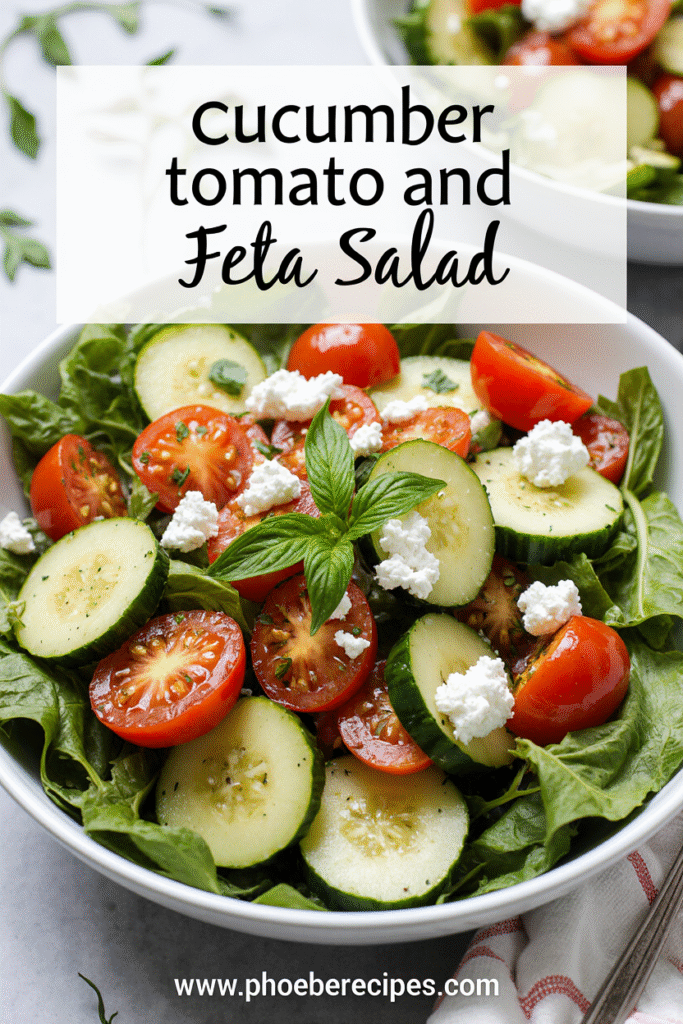The Secret to Perfect Cucumber Tomato Feta Salad (Chef-Approved Recipe)
Cucumber tomato salad feta combinations offer one of the most refreshing dishes you can make in just 10 minutes. I’ve always loved how this light, flavorful Greek salad brings together juicy tomatoes, crisp cucumbers, creamy feta cheese, and fragrant herbs in perfect harmony.
This tomato cucumber feta salad is actually a nutritional powerhouse too – with just 82 calories per serving, it’s as healthy as it is delicious. When I make cucumber feta tomato salad at home, I appreciate that it’s made almost entirely from what grows in my garden (or what I can find at the farmers market). Additionally, this cucumber and tomato salad with feta stays fresh in the refrigerator for up to 5 days, making it perfect for meal prep. Whether you call it a Greek cucumber salad or simply a summer staple, I’m excited to share my chef-approved secrets that elevate this classic dish from good to absolutely exceptional.
Choosing the Right Ingredients
The magic of a perfect cucumber tomato feta salad begins with selecting the highest quality ingredients. In my experience, this seemingly simple dish shines brightest when each component brings its best qualities to the bowl.
Best tomatoes for flavor and texture
For this refreshing salad, I prefer using ripe heirloom tomatoes that offer beautiful colors and complex flavors. Cherry or pear tomatoes make excellent alternatives, providing sweet bursts of flavor with every bite. The goal is to have all components roughly the same size for a balanced bite, so I cut larger tomatoes into bite-sized pieces. Fresh, in-season tomatoes make all the difference – this isn’t a dish that works well with pale, winter hothouse varieties.
Cucumber types: English vs Persian
While both varieties belong to the same species (Cucumis Sativus), there are notable differences. English cucumbers measure about 12 inches in length, while Persian cucumbers are smaller at approximately 6 inches. Persian cucumbers offer a crunchier bite and slightly more pronounced sweetness compared to their English cousins. Both have thin, edible skins and minimal seeds, eliminating the need for peeling or seeding. I find Persian cucumbers ideal for this salad due to their firmness and crisp texture, though English cucumbers work perfectly well too.
Why block feta is better than crumbled
Though convenient, pre-crumbled feta often contains anti-caking agents that make the cheese harder and drier. Block feta, however, delivers superior flavor and creamier texture, making it worth the minimal extra effort of cubing or crumbling it yourself. In my opinion, since feta is a star ingredient in this salad, choosing a high-quality block makes a significant difference. Greek feta (made primarily from sheep’s milk) offers the classic salty punch that balances perfectly with fresh vegetables.
Fresh herbs that elevate the salad
Fresh herbs transform this simple salad into something extraordinary. Dill provides a distinctive flavor that complements the cucumber beautifully, while basil adds aromatic sweetness that pairs wonderfully with tomatoes. Furthermore, mint brings a cooling effect, parsley adds brightness, and oregano contributes an authentic Mediterranean touch. I recommend experimenting with herb combinations rather than limiting yourself to just one.
Oil and vinegar: what works best
For the dressing, extra virgin olive oil forms the foundation, with white wine vinegar or red wine vinegar providing the acidic balance. In contrast to complex dressings, this simple combination allows the vegetables’ natural flavors to shine through. The typical ratio I use is 2 parts oil to 1 part vinegar, with optional additions of honey, Dijon mustard, or lemon juice to round out the flavors.
Step-by-Step: How to Make Cucumber Tomato Feta Salad
Preparing a flawless cucumber tomato feta salad requires attention to detail at each step. Let me walk you through the process to ensure your salad turns out perfectly every time.
1. Prep the vegetables evenly
First, wash all vegetables thoroughly. For cucumbers, slice them into half-inch pieces, then quarter each slice for bite-sized chunks. If using English cucumbers, there’s no need to peel them as their skin is tender. For tomatoes, chop them into similar-sized pieces as the cucumber—if using cherry tomatoes, simply halve them. Slice red onions extra thin to prevent them from overpowering the dish. Uniform cutting ensures each forkful contains a perfect balance of flavors.
2. Cube or crumble the feta
Although pre-crumbled feta is convenient, starting with a block provides superior texture and flavor. Cube the feta into small pieces or crumble it by hand, depending on your preference. Add the feta last when assembling the salad to prevent it from breaking up too much during mixing. This preserves those beautiful white chunks against the colorful vegetables.
3. Mix the dressing separately
In a small bowl or mason jar, combine 2 tablespoons olive oil, 2 tablespoons lemon juice or vinegar, minced garlic, and seasonings like salt, pepper, and herbs. Optional additions include honey for sweetness or Dijon mustard for tanginess. Whisk thoroughly or shake the jar vigorously until the dressing is well-emulsified.
4. Combine and toss gently
Place all prepared vegetables in a large mixing bowl, allowing ample room for tossing. Pour the dressing over the vegetables and mix until evenly coated. Afterward, gently fold in the feta cheese, being careful not to break the cubes too much.
5. Chill before serving (optional)
Although you can serve this refreshing cucumber tomato feta salad immediately, chilling it for 15-30 minutes allows the flavors to meld beautifully. For best results, add the dressing just before serving to maintain the vegetables’ crispness. Properly stored in an airtight container, this salad stays fresh in the refrigerator for up to 5 days.
Chef Tips for the Perfect Salad
As a professional chef, I’ve discovered that mastering a few key techniques can transform an ordinary cucumber tomato feta salad into a restaurant-quality dish. These insider tips address common problems home cooks encounter.
Avoiding soggy cucumbers and tomatoes
The high water content in cucumbers (96%) and tomatoes (90%) often leads to a watery mess at the bottom of your bowl. To prevent this, remove cucumber seeds with a teaspoon after halving them lengthwise—this eliminates the watery center while preserving the crunchy outer flesh. Likewise, consider deseeding tomatoes by cutting them in half and scooping out the seed-filled jelly. Alternatively, salt your chopped vegetables and let them drain in a colander for 10-30 minutes before assembling your salad.
When to add salt and dressing
Timing is everything with cucumber tomato feta salad. Add salt just before serving, as it draws moisture from vegetables, making your dressing thinner over time. For dressing, either add it immediately before serving or let the salad marinate for 2-3 hours maximum to enhance flavors without sacrificing texture. To prevent overwhelming delicate ingredients, add dressing incrementally, tossing and tasting as you go.
Balancing acidity and fat
Most chefs follow a simple formula for perfectly balanced dressings: three parts fat (olive oil) to one part acid (vinegar or lemon juice). This ratio ensures your salad isn’t too greasy or excessively sour. To add complexity, incorporate a small amount of honey or maple syrup with garlic for nuanced sweetness. Remember that acidic components counteract richness, creating harmony in your greek cucumber salad.
How to layer flavors with herbs and spices
Soft herbs dramatically elevate cucumber and tomato salad with feta. Consider using a combination rather than a single herb—mint pairs beautifully with chives, whereas dill complements parsley. Importantly, add delicate herbs at the end after dressing the salad to preserve their color and prevent wilting. Match the robustness of your dressing to your ingredients—lighter vinaigrettes for tender greens, thicker dressings for heartier components.
Customizations and Add-Ins
What I love most about cucumber tomato feta salad is its incredible versatility. The classic combination serves as a perfect canvas for creative additions that can transform this simple dish into something truly special.
Add red onions or shallots
Red onions bring a vibrant pop of color and a pleasant bite to this refreshing salad. I recommend slicing them very thinly to avoid overpowering the other ingredients. An important tip to remember: the red onion flavor intensifies significantly after a few hours, especially when combined with acidic dressing. Therefore, if you’re not planning to serve the salad immediately, consider adding the onions just before serving. For those who find raw red onions too assertive, shallots offer a milder alternative with a slightly sweeter profile that complements the cucumber tomato feta combination beautifully.
Try olives or capers for briny flavor
For an authentic Mediterranean twist, Kalamata olives make an excellent addition to your cucumber tomato feta salad. These deep purple olives contribute a rich, briny flavor that pairs wonderfully with the creamy feta. Alternatively, capers provide a similar salty punch in a smaller package. Plus, for an unexpected textural element, try pan-frying drained capers in a little olive oil until they puff up and become crispy – they create a delightful crunchy garnish that elevates the entire dish.
Use dill, mint, or basil for variety
Fresh herbs dramatically transform the flavor profile of this versatile salad. Dill gives the salad a Scandinavian feel with its distinctive taste that pairs exceptionally well with cucumbers. Meanwhile, mint contributes a cooling effect perfect for hot summer days, and basil lends an aromatic sweetness that complements tomatoes perfectly. Oregano adds an authentic Greek touch, whereas parsley brings brightness to the overall flavor. Feel free to experiment with combinations rather than limiting yourself to just one herb.
Make it a meal with chickpeas or grilled chicken
To transform this side dish into a satisfying main course, protein-rich additions are key. Chickpeas not only provide plant-based protein but also contribute a pleasant nutty flavor and hearty texture. Grilled chicken breast, cooked salmon, or shrimp can turn this light salad into a complete meal. Even white beans or lentils work beautifully, adding substance without overwhelming the fresh vegetable flavors.
Conclusion
This refreshing cucumber tomato feta salad stands as one of my favorite dishes for good reason. The combination of crisp vegetables, creamy cheese, and bright herbs creates a harmonious blend that satisfies both the palate and nutritional needs. Additionally, the versatility of this Mediterranean staple allows endless customization while maintaining its essence.
Remember that quality ingredients truly make the difference in this seemingly simple dish. Fresh, in-season tomatoes, crisp cucumbers, block feta cheese, and vibrant herbs form the foundation of excellence. Equally important are the techniques – uniform cutting, proper seasoning timing, and gentle handling – that elevate home cooking to restaurant quality.
The beauty of this salad lies not only in its delicious flavor but also its practicality. Ready in just 10 minutes, packed with nutrients, and staying fresh for up to five days, it serves as an ideal option for busy weeknights or meal prep Sundays.
Whether you enjoy this salad as a light lunch, refreshing side dish, or transform it into a hearty meal with protein additions, you’ll appreciate its vibrant flavors and textures. After all, some dishes become classics because they perfectly balance simplicity and satisfaction – and this cucumber tomato feta salad undoubtedly belongs in that category. Give this recipe a try, and I’m confident it will become a regular feature on your table throughout the warmer months and beyond.
FAQs
Q1. What’s the secret to making a flavorful cucumber tomato feta salad? The key is using fresh, high-quality ingredients. Choose ripe tomatoes, crisp cucumbers, and block feta cheese. Uniform cutting, proper seasoning timing, and gentle handling also elevate the dish. Adding a variety of fresh herbs like dill, mint, or basil can enhance the flavor profile.
Q2. How do I prevent my cucumber tomato feta salad from becoming soggy? To avoid sogginess, remove cucumber seeds and consider deseeding tomatoes. You can also salt the chopped vegetables and let them drain in a colander for 10-30 minutes before assembling the salad. Add dressing just before serving or let the salad marinate for a maximum of 2-3 hours.
Q3. Can I prepare cucumber tomato feta salad in advance? Yes, this salad can be prepared in advance and stays fresh in the refrigerator for up to 5 days when stored properly. However, for best results, add the dressing just before serving to maintain the vegetables’ crispness.
Q4. What’s the ideal dressing ratio for cucumber tomato feta salad? A balanced dressing typically follows a ratio of 3 parts fat (olive oil) to 1 part acid (vinegar or lemon juice). This ensures the salad isn’t too greasy or excessively sour. You can also add a touch of honey or maple syrup for complexity.
Q5. How can I turn this salad into a complete meal? To transform the salad into a satisfying main course, add protein-rich ingredients. Chickpeas, grilled chicken, cooked salmon, or shrimp work well. Even white beans or lentils can add substance without overwhelming the fresh vegetable flavors.


